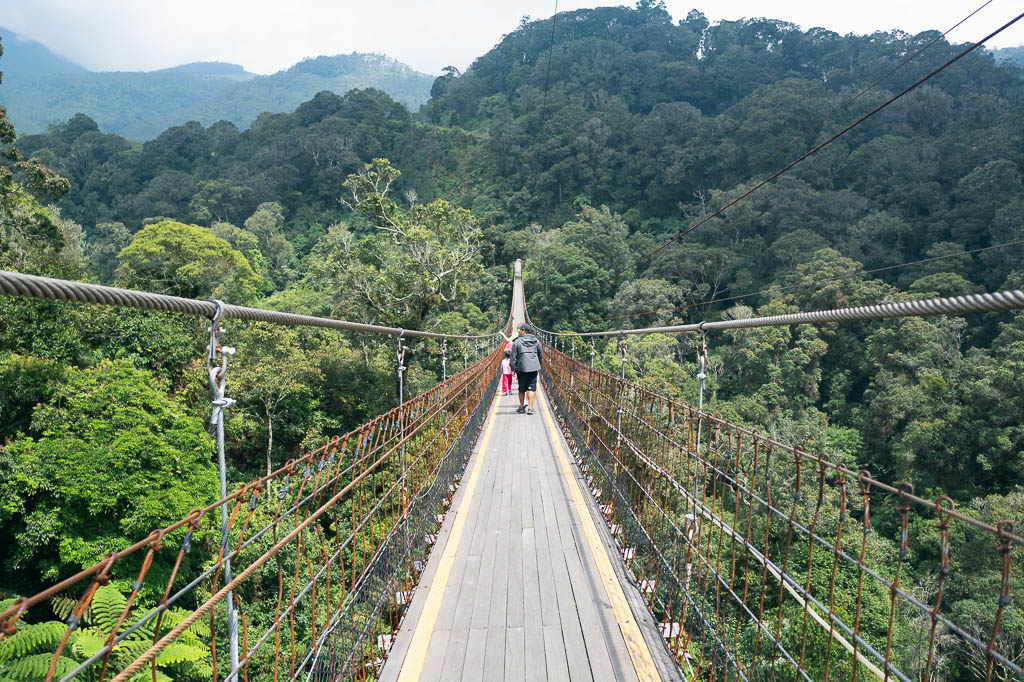
Planning to travel in Southeast Asia? Then you’ve made an excellent choice!
Southeast Asia is easily one of the world’s best regions to travel independently, offering more adventure than you can shake a stick at — and on average being incredibly inexpensive too.
“But how much time do you need to see Southeast Asia?”, you might ask. Honestly, as much time as you possibly have.
I would call myself a Southeast Asia expert at this point and even though I’ve travelled the region inside out, I still keep making new discoveries. SE Asia is addictive!
In this guide, I will suggest plenty of ideas for bite-size trips as well as some sentational voyages to tackle if you’re a career break, gap year, or travelling nomadically.
 A little introduction… here’s me, age 29, spelunking in Thailand on my first Southeast Asia backpacking trip through 9 countries
A little introduction… here’s me, age 29, spelunking in Thailand on my first Southeast Asia backpacking trip through 9 countries  Hi, me again! Now age 42, on a 2-month trip going off the beaten path through Indonesia — my 6th big trip through the region.
Hi, me again! Now age 42, on a 2-month trip going off the beaten path through Indonesia — my 6th big trip through the region.
My first backpacking trip to Southeast Asia lasted a whopping nine months. It certainly felt like having an ocean of time, but I still barely scratched the surface. Rest assured, it’s also entirely possible to have an incredible experience lasting a couple of weeks or months, in which you can cherry-picking some of the best Southeast Asia has to offer.
Your only challenge will be in deciding where to go and how much time to spend in each place.
And that can be easier said than done…
So before I get into some example travel routes for Southeast Asia, let me share a few general tips on how to put together an itinerary of your own.
Firstly: Don’t bite off too much!
The map below shows the key Southeast Asia backpacking routes. You’ll often find other travelers going down these lines, hitting up some of the region’s top sights.
These areas offer some great starting points for trip research. But regardless of how much time you have available, you’ll surely quickly find yourself with more ideas than you can realistically fit.
So, firstly: be sure to pace yourself!
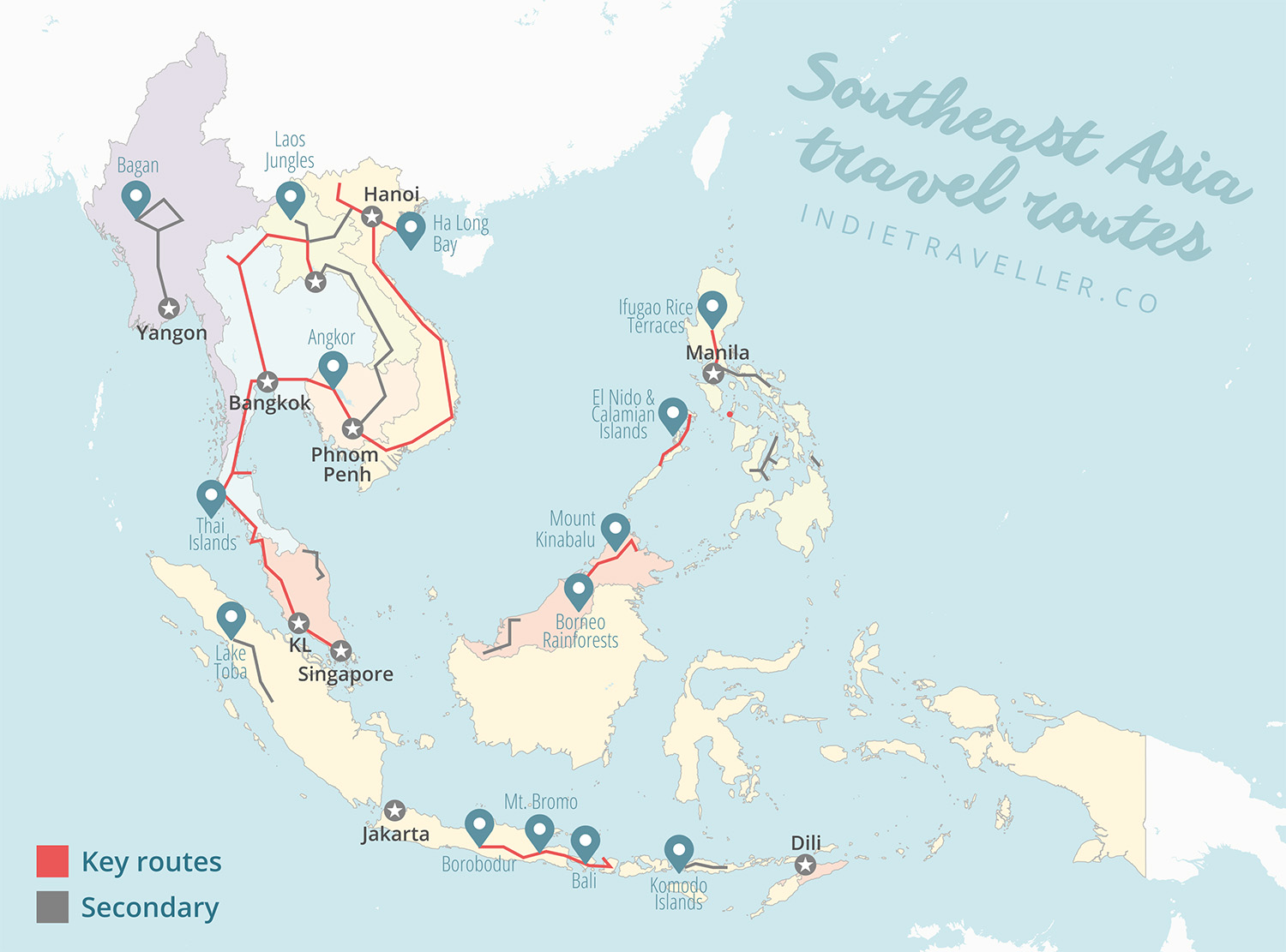
I know you’ll be intensely tempted to include every single highlight listed in the travel guides. But unless you have all the time in the world, chances are your route is already too ambitious.
I see this happening time and again: travelers wearing themselves out completely by trying to fit in way too much.
Readers of this blog often ask me if, say, three weeks is enough to see Thailand, Laos, Cambodia, and Vietnam. It’s technically possible, but I don’t recommend it.
Why?
Well, you would probably need another holiday just to recover from such a hectic schedule! And when you’re frantically pinballing around the region, you’re likely to experience most places only fleetingly.
Sure, you’ll have spent a few days in another country, but that does really count? And are those days maybe better spent having more experiences and less time lost in transit? If you ask me: yes!
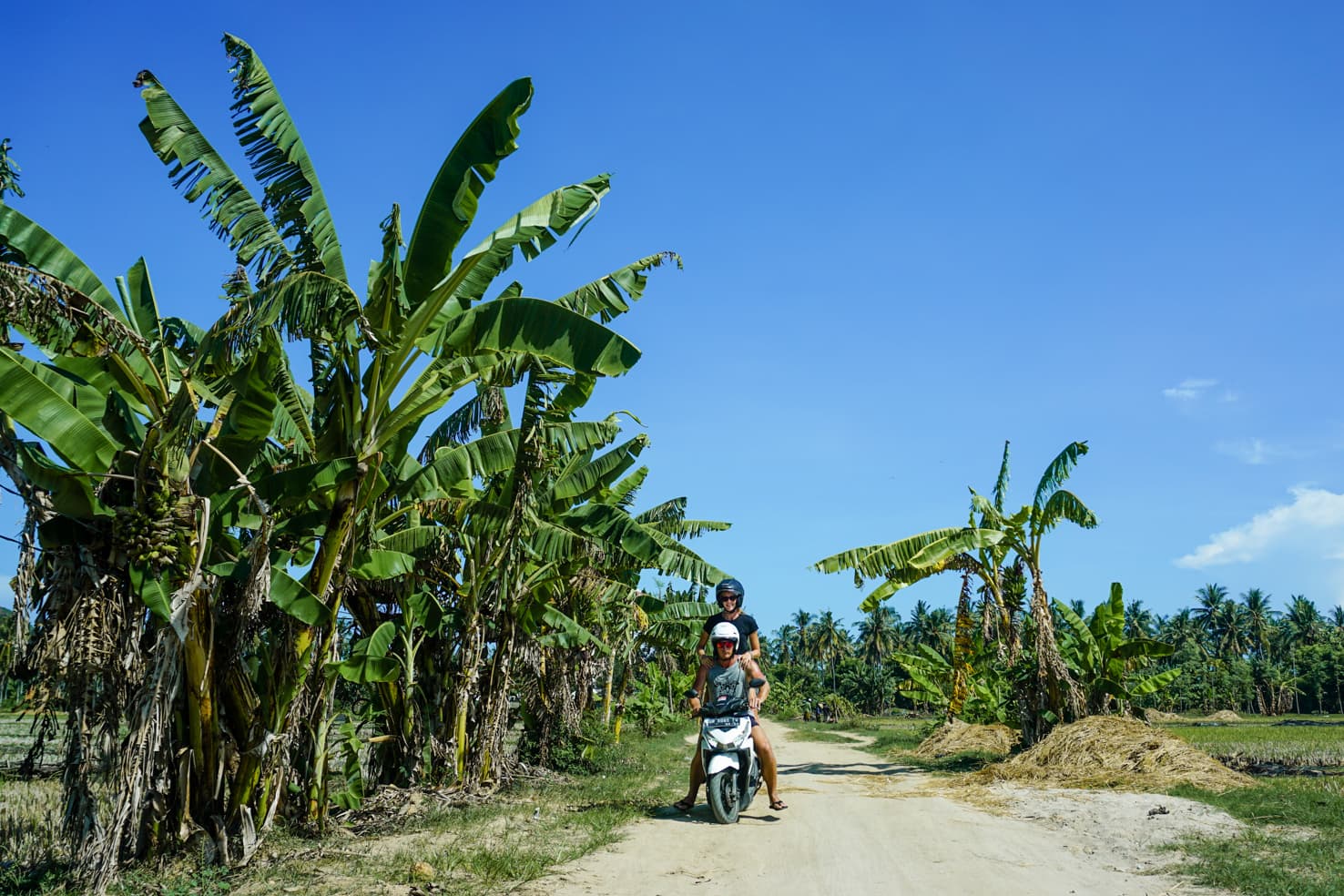
Cutting back and streamlining your itinerary can actually improve your trip.
Here are a few reasons why:
- You will have more time to truly get to know a country instead of just ticking things off a list;
- A tighter route typically means more time to experience things, and less time and energy wasted in transit;
- You’ll have more opportunities to go beyond the most obvious tourist hubs.
If you still think your trip would be better by spending short amounts of time in lots of country, that’s okay! Not everyone likes to travel the same way. But personally, I think it’s often better to focus.
Balancing your Asia itinerary
Besides not stretching yourself too thin, I recommend having a good mix of Big Things as well as small things in your itinerary.
What do I mean?
Well, in your trip research, your attention will inevitably be drawn to Big Things. I’m talking about UNESCO world heritage sites and other famous or epic are often shown in drone shots on social media. Southeast Asia is full of them.
Maybe you already know about the towering limestone islands of Ha Long Bay in Vietnam, or the epic temples of Angkor Wat in Cambodia, or the famed beaches and islands around Krabi in Thailand.
These places are so iconic that they often appear first in videos about these countries, or you’re guaranteed to find them in ‘top 10’ lists.
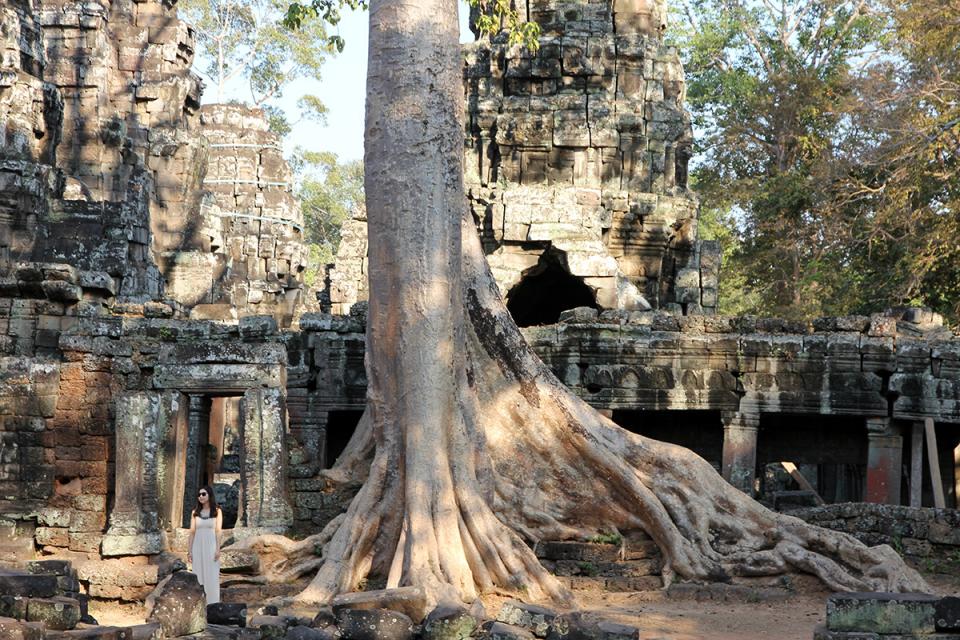 Angkor Wat
Angkor Wat
Now, such places are definitely highly worth visiting, but in truth they are usually also rammed with tourists and selfie sticks. They’re still awesome, but they also represent a specific kind of experience.
While it’s great to have several of these major sights in your itinerary, especially for that pure wow factor, it should not be an obligation to see them all.
Personally, I think it’s fun to mix them with some lesser-known places that may have a bit more local character.
Many of my favorite travel memories in Asia are actually not of grand or iconic locations. I often think back fondly to simply riding a scooter through rice fields in northern Thailand, watching the sunset over the Mekong river in Laos, or enjoying a delicious bowl of Pho noodles at a market in Vietnam. Maybe they don’t make for ‘epic’ videos but they are amazing and highly personal experiences.
If you’re finding it impossible to fit in all the big bucket list items, don’t beat yourself up about it. Your route simply may not be able to capture them all. Just know that between the famous sights there are so many smaller things you may enjoy just as much. They might not be the headline-grabbing attractions, but they’re the parts of your journey you’ll remember the most.
Now enough with the disclaimers… let me share a few ideas!

Southeast Asia in 2 weeks
Two weeks is honestly not a whole lot to be thinking about an entire region, but you can still get a great taster of a specific country or area.
Some 2-week itineraries I’ve seen suggest flying everywhere and spending only two or three days per country, trying to capture as many Big Things as possible, but I think that’s a bit of a waste. Such a whirlwind tour will be very tiring and isn’t going to capture what’s so truly great about this region.
Instead, consider just picking one country, then make the most of your time there. I know that might feel unambitious, but it lets you be more ambitious within that country.
There are many excellent choices for a 2-week adventure in Southeast Asia. Thailand is a great starter country and you can check out my Thailand itinerary for a rough template. I have many more trip ideas in its own post.
my 2-week itinerary suggestions 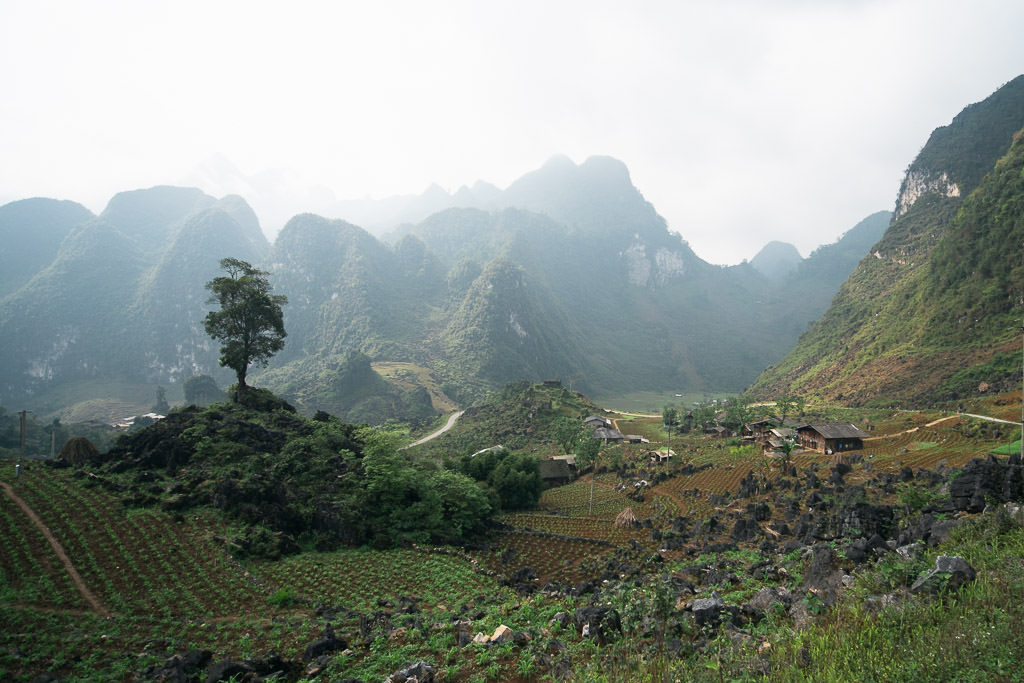 Northern Vietnam
Northern Vietnam
Southeast Asia in 4 weeks
4 weeks gives you much more to work with, though I would still advise against adding tons of countries. I would focus on the two countries that call out to you the most. (You can maybe add a third country to spend a shorter time in.)
Some neighboring countries combine especially well. For example, Thailand and Laos. Thailand is more developed and has a lot of entertainment on offer, while Laos is mostly rural, wild, and sparsely populated, with some amazing opportunities for jungle trekking and cultural travel. A neat loop through northern Thailand and northern Laos will give you the best of two worlds.
Or combine Vietnam and Cambodia. Start in northern Vietnam, visit Halong Bay, and then work your way south. Vietnam alone could take you 2,5 or 3 weeks; keep at least one week free to dip into Cambodia to see the temples of Angkor Wat. End your trip with some quality beach time on the Cambodian islands, or Thailand’s Koh Chang archipelago.
I like picking adjacent countries as I enjoy traveling mostly overland, as somehow this makes the trip feel more like a journey. Most of my trips in Southeast Asia have been backpacker-style, where you mainly travel by bus or train.
Of course, you could also split your time between two separate countries and fly between them. If you want to go to Indonesia, The Philippines, or the Borneo part of Malaysia, you’ll have to fly anyway. You can have a look at my 2-week itineraries and put two of them together for an epic 4-week trip.
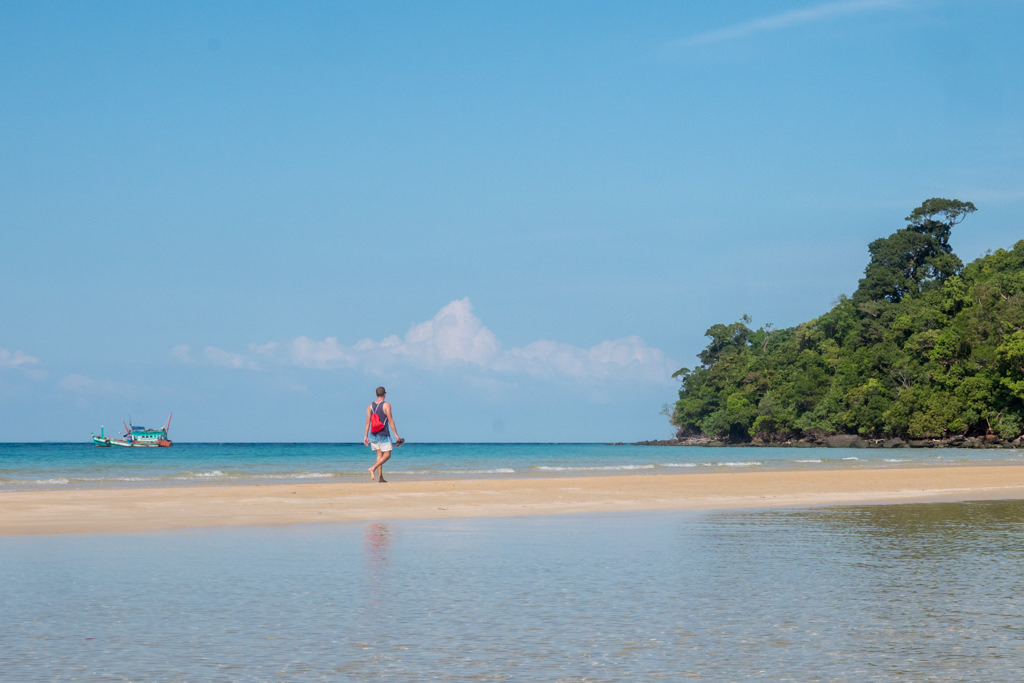 Koh Rong Sanloem, Cambodia
Koh Rong Sanloem, Cambodia
Southeast Asia in 2 months or more
2 months is the perfect minimum time to enjoy all four countries in mainland Southeast Asia and travel through them overland without having to rush.
With at least 6 to 8 weeks you can follow the complete so-called Banana Pancake Trail, a famed Southeast Asia backpacker route that mainly runs through Thailand, Laos, Cambodia, and Vietnam (though it has many other tendrils through other countries). Even if you don’t call yourself a backpacker you may still wish to know about this route, as it’s a well-honed circuit that covers a ton of amazing highlights.
In case you were wondering, the Banana Pancake Trail was named after the guesthouses that were all starting to sell banana pancakes back when hippies were trailblazing around this region in the 1970s. At the time this pancake breakfast offered the only alternative to the usual rice-based meals.
The name doesn’t make that much sense anymore, but it’s what stuck!

Due to having so many international flight connections, many people start their trip in Bangkok. To a lesser degree, Kuala Lumpur and Singapore are also common entry points into the region. But if in doubt, Bangkok is always a great place to kick off your adventure.
You can get some ideas from my Thailand itineraries for how to plan an initial route in Thailand. Head north up to Chiang Mai, then head for Chiang Rai and the Laos border.
Many backpackers then like to take the two-day slow boat from the Laos border to Luang Prabang along the Mekong. It’s wonderful to see the landscape slowly change and to get a glimpse of the locals living along the river. The boat is also a great way to meet other travelers. On my first journey through Southeast Asia, I kept meeting people from that boat for many weeks after.
Be sure to spend some time in northern Laos! I think it’s an incredibly scenic and underrated part of the region. It’s very mountainous, covered in jungle, and is great for nature activities.
If you’re following the classic route from Luang Prabang down to Vang Vieng and the capital of Vientiane, it may be worth flying to Vietnam from there. While infrastructure is improving in Laos, overlanding from Vientiane to Hanoi still makes for a soul-destroying 25+ hour bus journey that you may wish to skip.
Work your way down Vietnam, then through Cambodia, and end your trip lazying on the Thai islands.
Psssst, are you insured for a long trip?
Travelling in Southeast Asia can be a little adventurous, which is why I always recommend getting travel insurance so you’ll be covered in cases of theft, medical emergencies, cancellation, and much more.
BUT… did you know normal annual insurance plans often ONLY cover shorter holidays and not longer trips?
The maximum on most plans is only 30 days. With Heymondo Annual Multi-trip your maximum is 60 days. If your trip is under 2 months, this plan offers the best value (I’ve used this plan myself for 5+ years now).
You can also get single-trip insurance just for your Southeast Asia trip, which will cover you even for trips longer than 60 days. If your trip is open-ended, you can even extend your coverage while you’re still traveling.
There are a lot of advantages to having travel insurance, but for me the main thing is coverage for medical accidents, something that can be enormously expensive if you don’t have any coverage abroad.
Budget-friendly insurance for Asia

Travel insurance will cover you for theft, medical emergencies, trip cancellation, and much more.
I always use Heymondo, which offers great coverage, no excess or deductibles, and an app with 24/7 assistance & doctor chat for more peace of mind when you travel.
Get a quote at heymondo
My alternative highlights route
The route above is roughly how I traveled the Banana Pancake trail way back in 2012-2013 as a rookie backpacker following more or less the tried-and-true path.
Knowing what I know now from the trips in the years since — and if I had to cherry-pick — I would create a different route. Think of it as an “alternative Banana Pancake trail” with more focus on nature and rural regions, and a bit less on cities or overly touristy areas.
Some of the most key changes:
- This route leaves out Vientiane in Laos, as I humbly think it’s one of the dullest capitals in the region. I’ve switched Vang Vieng for Nong Khiaw.
- More stops in the mountainous central and north Vietnam (my favorite regions).
- Added southern Laos for a gentle Mekong experience and to see some of the region’s most beautiful waterfalls near Pakse
- Less time in southern Thailand, which tends to be more commercial and expensive (though admittedly it can be a lot of fun!)
I think this route will be interesting if you’d like to add some quieter or more ‘authentic’ places, for lack of a better word.
While I’ve left out much of Thailand, this country is always an option to come back to even on a shorter holiday. Since Thailand’s beaches and islands are so accessible and great for a shorter trip, I consider them less essential on a bigger journey, but only if I really had to choose of course.
 My ‘alternative Banana Pancake’ route. Perfect if you have at least 8 weeks or so.
My ‘alternative Banana Pancake’ route. Perfect if you have at least 8 weeks or so.
Some of the highlights along this route:
- Rent a motorbike and do the Mae Hong Son loop for a great slice of rural Thailand
- Luang Namtha in northern Laos is a great jumping-off point for hill tribe and jungle hikes.
- Visit the UNESCO World Heritage city of Luang Prabang, known for its French colonial architecture and Mekong River views
- Go to Nong Khiaw for waterfall treks and other adventures. The landscape and activities here are a bit similar to Vang Vieng but less touristy.
- See lush rice fields and karst landscapes around Ninh Binh. Consider staying overnight instead of doing this as a day trip from Hanoi.
- Explore Vietnam’s traditional capital of Hanoi. It seems to be a love-it-or-hate-it place, but I think it’s absolutely wild and exciting. I’ve been to Hanoi thrice now and wrote this experiential guide to Hanoi in the hopes of inspiring more people to enjoy its street life and secrets.
- From Hanoi, you can also add a potential route extension into the mountainous northwest of Vietnam. The Ha Giang region is unbelievable; either rent a motorbike or join a tour where you can sit in the back.
- Take a cruise to Bai Tu Long Bay instead of Ha Long Bay. It takes a day longer but has fewer crowds. Another option is to stay on the island of Cat Ba.
- Stop at Phong Nha for caving adventures. You’ll find here some of the most unique and largest caves in the whole world. The town also has a fun and laidback hostel/bar scene.
- Go to Hoi An, a pleasant town known for its colorful lanterns at night.
- Head to Pakse and consider exploring the Bolaven Plateau, which has some of Laos’ prettiest waterfalls.
- Chill at the riverine archipelago of Si Phan Don.
- See the epic temples of Angkor Wat near Siem Reap
- Relax on the islands of Cambodia and/or southeast Thailand. These islands remain less commercialized than the more famous ones in southwest Thailand (like Koh Phi Phi). I wrote here about my time on a beach on Koh Rong Sanloem, a very laidback place.
Of course, there are a million ways to travel through Southeast Asia and this is just one other way.
This suggested route stitches together various pieces from trips I’ve done. I should mention I’ve not done the overland trip from central Vietnam (Hoi An) into south Laos (Pakse), which could involve multiple minivans. Other segments do have direct connections by bus or train.
If you’re doing this as a (solo) backpacker, the only downside to this route is that occasionally you’ll be going in another direction than most other travellers. For instance, I’d guess that 80%+ of backpackers in Luang Prabang go to Vang Vieng in the south next, but in this route we’ll go going to Nong Khiaw in the north instead (and potentially backtracking). But that’s just what happens if you want to go slightly off the usual path.
 A slimmed down version of my alternative route, leaving out Vietnam. While I love Vietnam it can take a lot of time, so this is a really nice route to tackle if you have about 4 or 5 weeks minimum. I did almost this exact route on a return visit to the region.
A slimmed down version of my alternative route, leaving out Vietnam. While I love Vietnam it can take a lot of time, so this is a really nice route to tackle if you have about 4 or 5 weeks minimum. I did almost this exact route on a return visit to the region.
Expanding your Asia route
I’ve focused so far on the four mainland countries as they allow for various overland routes with many public transport connections. With more time to spare or added flights, there’s a whole other chunk of Southeast Asia to consider.
Traveling to Malaysia makes for an obvious extension from southern Thailand. It’s a more conservative country with a quieter atmosphere than Thailand, though the nature and its diverse mix of cultures (Malay, Indian, Chinese) are a big part of its appeal. Malaysian Borneo has some of the best wildlife experiences and the tallest mountain in the region.
Some of my favorite backpacking destinations are on Southeast Asia’s periphery. I’m a huge fan of Indonesia, which is best known for the crowd-pleasing island of Bali, though there are numerous other islands to consider. I’m a big fan of Lombok, Flores and the Komodo Islands, and Mount Bromo and the Ijen Plateau on Java are also amazing. Sulawesi is also a mindblowing region to tackle if you don’t mind going off the backpacker trail and having to deal with some long overland journeys.
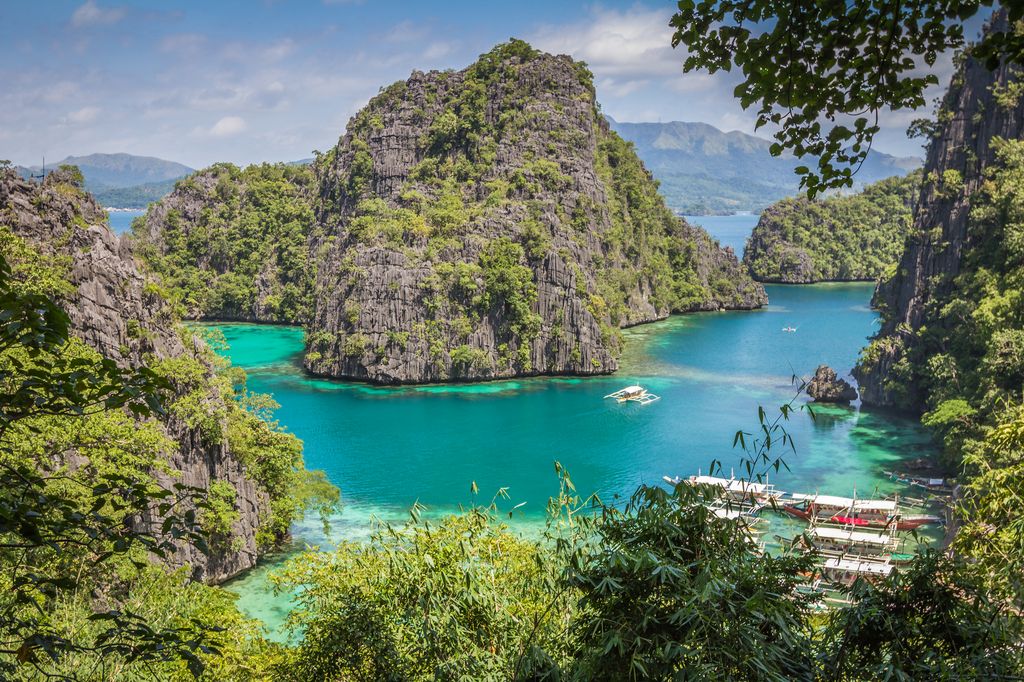 Coron, Palawan – Philippines
Coron, Palawan – Philippines
I also love The Philippines. It’s a bit far removed from everywhere else, but it’s worth it. It has some of the friendliest people (many of whom are English speakers) and some of the best beaches and islands. Palawan is probably the most known destination among backpackers and it’s gorgeous, though there are countless islands to choose from. You can check out my 2-week Palawan itinerary for some inspiration for a beaches-and-islands focused route.
Myanmar is another fascinating destination but sadly, it’s now embroiled in a civil war. Keep an eye on current events to know if it’s a good time to go to Myanmar. If things stabilize again one day, don’t hesitate to go there.
Or… make your own route!
What I’ve shared here is merely some common wisdom for backpacking Southeast Asia. But maybe you have different ideas, in which case you shouldn’t let anyone tell you what to do!
I have traveled a lot in Asia but, in the end, I’m just some guy with a blog who has a lot of biased opinions. Everything is subjective and everyone has different travel goals. You’ll often notice this in hostel rooms or at the breakfast tables in B&Bs when travelers share their stories; people can come away with totally different impressions of the same places.
Don’t be afraid to take some side-routes and create whatever crazy route you want. Equally, don’t be afraid to stick to the beaten track! Attempts at being original and going to some end-of-the-road place honestly didn’t always pay off for me. Sometimes I was just happier staying in a major location where it’s easier to meet other travelers, or it turned out that the more popular destination is so for a reason.
If you’re going on a longer trip, keep in mind not everything needs to be planned out in advance. Improvisation is very easy in Southeast Asia, so you can always just wing it and see where adventure takes you. You can speed up or slow down, add intriguing places other travellers tell you about, or skip sections that no longer interest you. Since accommodation and transport connections are generally so plentiful in Southeast Asia, you can take things one day at a time.
More help planning your trip
Hopefully, this article has helped you get some ideas for your Southeast Asia trip. But if you’re still feeling a bit overwhelmed, that’s understandable.
Apart from creating your route and selecting your destinations, there are many other issues to consider, like travel costs, visas, what to pack, vaccinations, safety issues, not to mention how to tackle some of the annoying challenges you may face on the road.
But there is only so much you can cover in a blog post!

Luckily, I also wrote a 272-page travel planning book that helps you with every possible question you might have before setting off on your journey. For the price of just one night in a Bangkok hostel, it will guide you in every possible aspect of planning your Southeast Asia trip.
Readers have called it “reassuring, inspiring, and specific” and “the single most helpful piece of writing I have read regarding travel”. (You can see many more reviews at Amazon).
This book is kind of my magnum opus: I took all the raw learnings and insights I picked up from traveling around the world for 12+ years, filtered them thoroughly, compressed them into pure travel wisdom concentrate, which I then carefully infused into every page for you to read.
Much of what’s in Travel the World Without Worries comes from my combined 14+ months of exploring Southeast Asia (as well as other parts of the world). The book is designed to help you with planning your trip, though along the way you’ll also learn about some of the stupid, silly, and incredible things I’ve experienced so that you can know what to expect.
To continue where this article left off, be sure to grab your copy.
Get first chapter for free
Source
